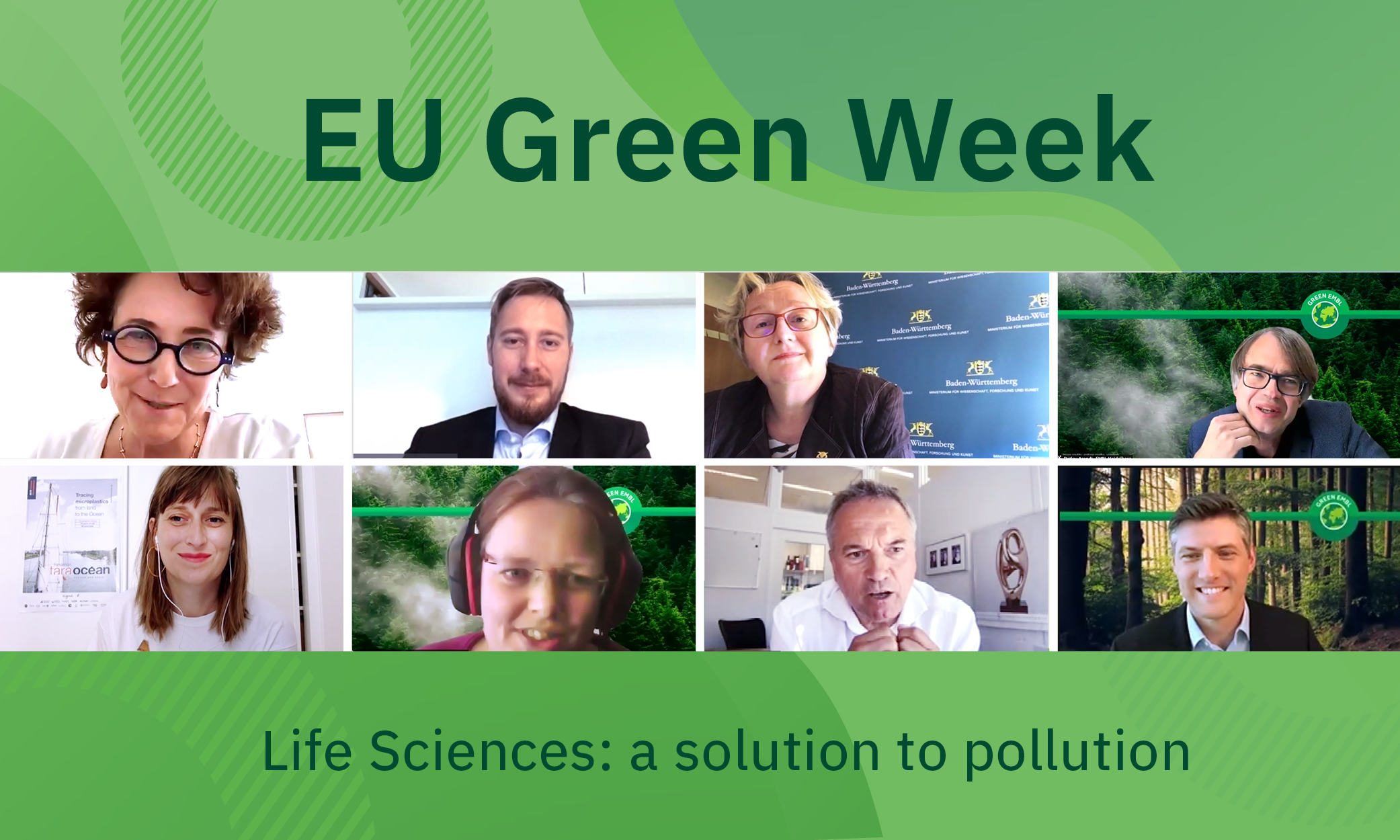
Molecular biology stepping up to solve environmental challenges
Collaboration, nanoplastics, and plankton in the spotlight as EMBL hosts EU Green Week forum

On 31 May, nearly 200 people tuned into a virtual event showcasing the various ways in which molecular biology – and specifically research at EMBL – can provide the knowledge needed to solve environmental challenges.
EMBL alumni Erin Tranfield and Julius Brennecke led the programme, which was filled with examples of how molecular biology can provide solutions to pollution. The event featured 10 speakers from science, industry, and government. The talks are now available online, but here are nine takeaways.
1. The life sciences can help us find solutions to environmental challenges.
As she outlined environmental concerns, EMBL Director General Edith Heard pointed to the natural progression of EMBL’s work to study life in the context of its natural environment, which is the core aim of the research in the next EMBL Programme, Molecules to Ecosystems, due to begin in 2022. “While remaining a fundamental research organisation, we plan to rise up to these new challenges, do research that’s relevant to these issues we’re facing, and find evidence-based solutions,” she said. “We plan to do this research sustainably and lead by example.”
2. Microbes could help address our pesticide problems.
Richard Jacoby, a postdoctoral fellow in EMBL’s Zimmermann group, shared a glimpse of his work to better understand how microbes break down pesticides, and which microbial species would be the most useful. According to Richard, only 1% of applied pesticides hit their target; 99% enter the environment. “Microbes are the main way pesticides are degraded in the environment. They can metabolise what other organisms find poisonous,” he said.
3. Nanoplastics are everywhere, and we need to understand the consequences.
Melissa Graewert, a senior technical officer in the Svergun group at EMBL Hamburg, talked about one of the group’s projects, which will deploy a specialised X-ray technology to detect and better understand the potential impact of nanoplastics on the environment. Characterisation of nanoplastics in the environment (taken from rivers, seas, and oceans) will allow the scientists to uncover what this plastic infiltration means for our health and our food supply. Only with this kind of understanding can scientists find solutions to tackle these issues.
4. Microorganisms represent 95% of marine biodiversity.
In 2019, the Tara Ocean Foundation launched a mission to sample microplastics flowing from the estuaries of nine of Europe’s major rivers. Romy Hentinger and Gabriel Gorsky shared how the foundation is now preparing for its next mission, which will focus on microorganisms – specifically, plankton. “We all exist thanks to the ocean,” Romy said. “It supports the highest biodiversity, provides living resources, absorbs carbon dioxide, regulates the climate. We all know about its importance, but we still know little about how it functions.”
5. EMBL provides the molecular perspective.
EMBL group leader Detlev Arendt elaborated on this area of EMBL’s future research. “We know that pollution has a negative impact,” he said. “But we don’t have a comprehensive view, and we don’t know how organisms react on a molecular level. Our aim is to study at the molecular and cellular levels how microbes, algae, plants, and animals interact with each other and respond to natural and anthropogenic environmental changes.”
6. Research itself needs to be more environmentally sustainable.
EMBL’s Environmental Officer, Brendan Rouse, kicked off the second session of the afternoon by outlining how EMBL plans to become a more sustainable organisation. “This event is an example of EMBL doing environmentally relevant research and promoting sustainable science,” he said. “We have installed solar panels and electric vehicle chargers, and removed plastic from our canteen, among other initiatives, but we are aware that small changes can also go a long way – turning equipment off, maintaining it properly, and reducing our use of laboratory consumables all add up.”
7. Lifestyle changes and empowerment of science equal progress.
As EMBL Director Matthias Hentze pointed out, there are two aspects to finding solutions to pollution. The first is to change behaviour. The second is to find new solutions through life science research. “Let’s look at the COVID crisis,” said Matthias, who launched EMBL’s Environmental Research Initiative in 2020. “We all knew that distancing and wearing masks would bring down the dimension of the problem. But, without science developing a vaccine in record-breaking time, we’d be in a really bad state now. What we learned is that just changing behaviours isn’t enough. The environment needs heavy investment into science.”
8. Industry–science partnerships can expand impact.
For HeidelbergCement, science is the way to a better future, as the company plans to make its end-product, concrete, carbon neutral by 2050 at the latest. Christoph Reißfelder spoke about the company’s challenges in a world dependent on cement for building materials, but with cement carrying a big carbon footprint. “The major challenge in cement production is carbon dioxide emissions,” he said. “We’re looking into deploying technologies that capture carbon and then use it. Politics, science, and industry have to work together in achieving a carbon neutral economy.”
9. Dialogue must continue.
In the event’s second session, industry and research representatives were joined by Theresia Bauer, Baden-Württemberg’s Minister of Science, Research and Arts. “The life sciences are the basis of our general knowledge and serve to connect different scientific fields and our diverse world,” she said. “They make the invisible visible and are key to tackling challenges like climate change and environmental pollution.”
The moderators and participants closed the event by encouraging exchange and cooperation across disciplines to solve global challenges. “When science is well explained, it enjoys great public trust,” Theresia said. “Scientists need to be involved in public policy and decision making, because they can push people to change their behaviour and make an impact on issues like environmental destruction.”
Want more than just the highlights? Watch the whole discussion online.


